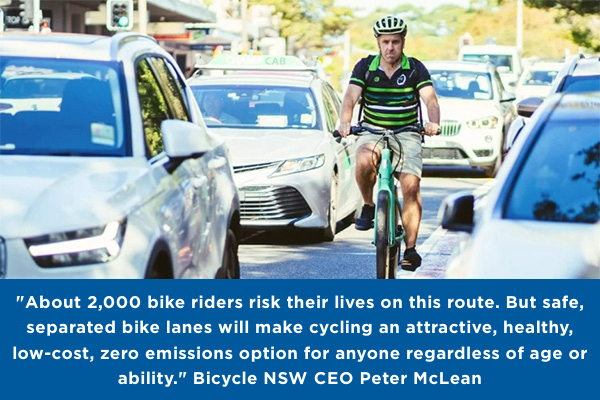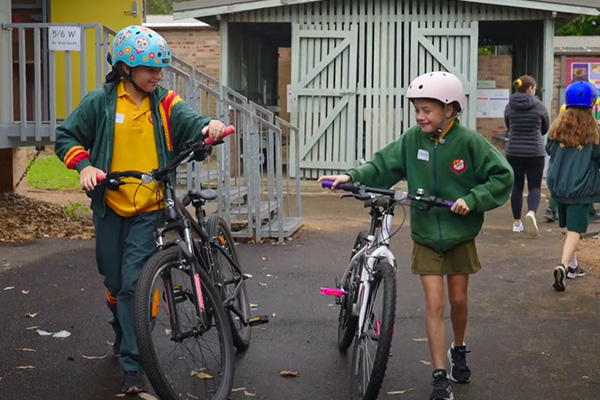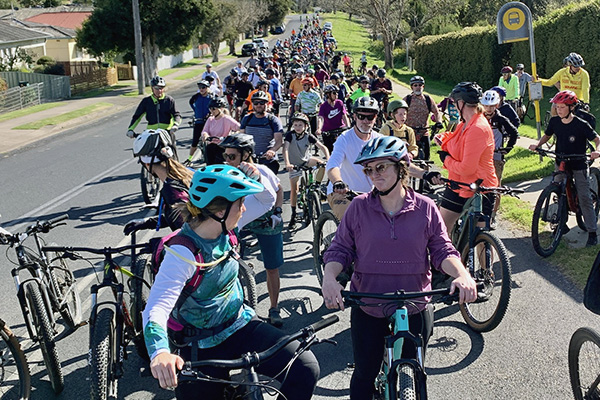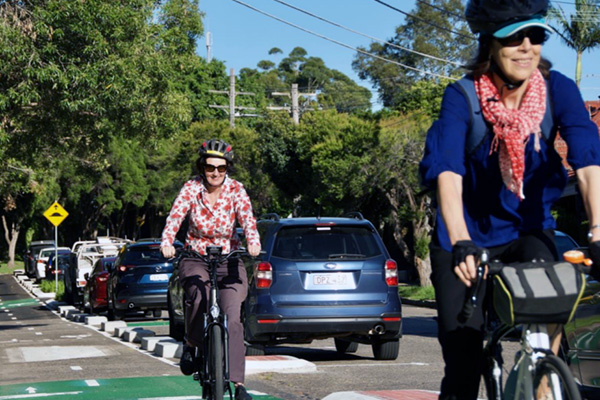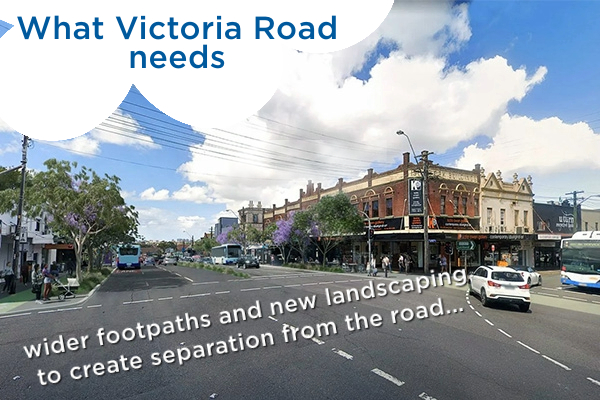Peter McLean, Bicycle NSW CEO
The NSW Government was under significant pressure to deliver a thrifty budget. On that measure it’s a relief to see a continuation of ongoing major active travel infrastructure projects. Labor also honoured its modest election commitment of a second $60 million tranche for active travel. This corresponds with the previous government's funding levels set at a traditionally low 0.2%. We will therefore continue to draw attention to the need for improved active travel funding for health, the environment and the economy in coming budget reviews. After all, properly funding walking and cycling is not only fair, it’s economically rational.
Peter McLean looks forward to a dedicated cycleway along Oxford St East. (Photo: Sydney Morning Herald)
Ongoing projects are safe
It's pleasing to see essential transport infrastructure has been kept without further privatisation of public assets. This includes the additional $60 million tranche for local councils to fund active transport projects, programs and infrastructure. We’re especially pleased about the establishment of an Active Transport Fund with further details to be announced. We’re hoping this will lead to enhanced education and awareness programs and fund the proposed Bicycle NSW active travel to schools program. Re-establishing a NSW Bicycle Week is yet another possibility. We look forward to more safe paths to schools facilitated by NSW Speed Zoning Standards that embrace 30km/h streets. We also note increased funding for rail and public transport which addressed another crucial demand.
Significant funding for active and public transport projects
- $98 M for the Active Transport projects that expand connected cycleway networks. This includes the Sydney Harbour Bridge Ramp, Stage 3 of the Sutherland to Cronulla Active transport Link (SCATL) and other unspecified projects.
- $22 B for three Sydney Metro projects - West, City and South West and Western Sydney Airport
- $374 M for the Parramatta Light Rail
- $114 M for transition to new zero emissions buses
- $30 M Opera House to Parramatta Walking and Cycling Link
- $30 M for the Women and Girls Safer Cities Program
There is huge investment into roads, rail and associated infrastructure like station car parks and accessibility. But Bicycle NSW will work to ensure this also includes active transport amenities to increase mode shift. And reduce the millions of car trips which are less than 2km each and every day.
More Active Travel to School programs such as the very successful Miranda North Public School Cycle to School Pilot (Credit: Sutherland Shire Council)
A missed opportunity to support families with the rising cost of living
Sufficiently funded active travel infrastructure and programs would help relieve cost of living pressures. And mode shift to sustainable transport would see significant private and public savings. Unlike the $615 million spent on Toll Relief which will exclusively benefit 700,000 Sydney-siders and encourage more driving (with associated pollution, congestion and inactivity once toll caps are reached).
Since roads were privatised, toll relief has been a perennial State election promise. But imagine what could be achieved for all NSW residents with a similar allocation of public money for better, safer and more connected walking and cycling infrastructure.
South Coast residents and visitors would love to ride more and drive less, but more safe places to ride are desperately needed (Credit: Bega to Tathra Safe Ride)
A missed opportunity for health
We understand that governments need to honour their promises, and in a number of electorates, that includes roads. But ensuring active transport is integrated into each of these projects would guarantee maximum social and economic return. And minimum waste. Firstly, active travel infrastructure costs a fraction of what it takes to build motorways and requires a lot less space. Just 3.4 km of the M1 extension at Hexham, for example, will cost $2.1 billion. But long term it’s never going to fix congestion.
Yet imagine what $2.1 billion could do for walking and cycling for generations to come. What’s more, it returns 5:1 on the dollar, minimum. That’s because whilst road traffic incurs a massive deadweight loss due to congestion, deaths, hospitalisations and deadly emissions, walking and cycling do the opposite. This is why, after decades of car-first policy, we’re saying enough’s enough
Let's get serious about walking and cycling.
Net zero depends on mode shift and more women riding: 70% more women say they would ride with safe, separated infrastructure (Credit: Transport for NSW)
A missed opportunity for the environment
Another NSW Government election commitment is to deliver a 70% cut in emissions by 2035 compared to 2005 levels. This was the Net Zero pledge. Given transport is the second most polluting sector (soon to be the first), we need to promote active travel over driving. The budget however, remains staunchly car-first despite the fact that EVs will not reach this target in time. Indeed, $633 million dollars for EV subsidies and infrastructure won’t come close to decarbonising the network. Nor is there mention of e-bike subsidies which would go much further, faster. We look forward to discussing this environmental and transport equity campaign with the Government pending future budget reviews.
Ideally, there would be no need for an active transport budget allocation
This seems counter-intuitive. But when active transport is prioritised, road space is reallocated accordingly. Right now we’re in a holding pattern of governments talking about active transport. We'd prefer to see the NSW Government put their fine policies and frameworks into action by entrenching active transport into all transport projects.
As we have seen in the past, bolt-on solutions cost too much and are less effective. Active transport is a legitimate and highly efficient form of transport which needs to take its rightful place in our transport network.
Bicycle NSW looks forward to working with the NSW Government to help deliver critical education and awareness programs. And we will continue advocating for improved infrastructure and a safer bicycle riding environment.
Victoria Road needs to be completely re-imagined. The reallocation of road space for wider footpaths, cycleways, landscaping and new crossings is a key Bicycle NSW campaign.
(Credit: Rozelle Public Domain Master Plan)
Just one more thing
Not only do we have the best bicycle insurance, but Bicycle NSW has been actively campaigning for 47 years in NSW for better infrastructure for bike riders of all ages and abilities. Join us now and support our campaign for Better Streets.

